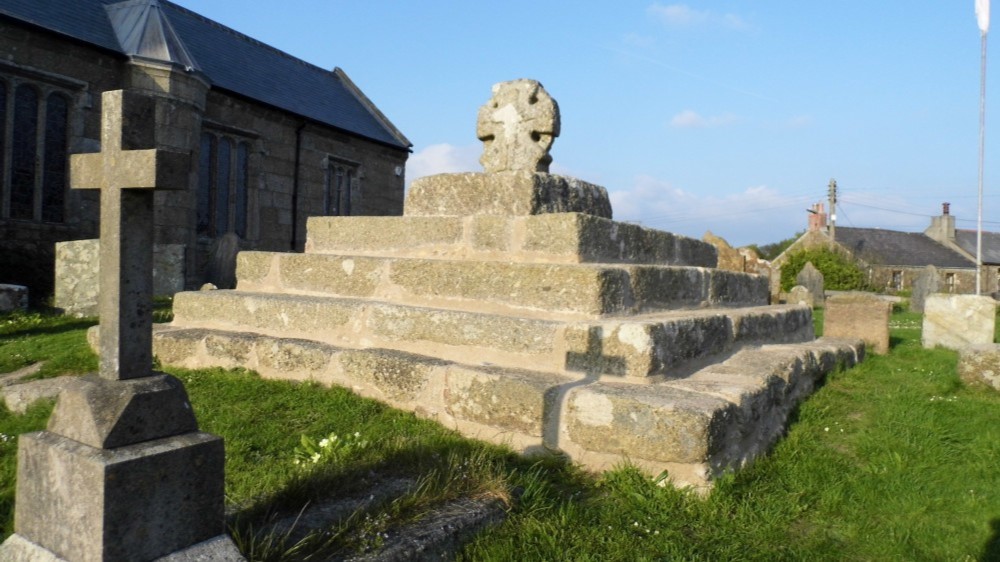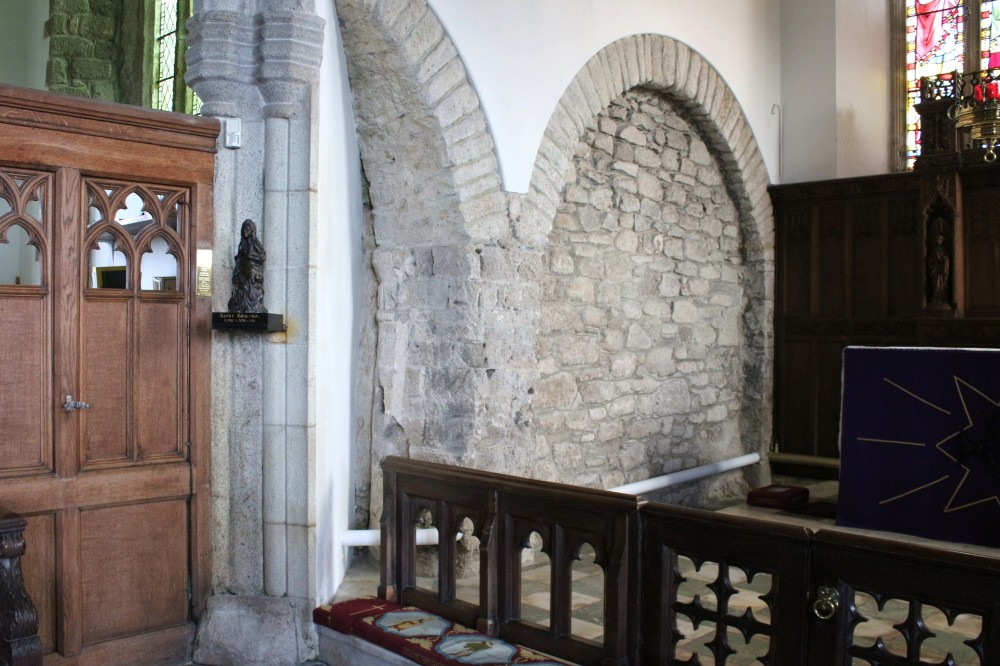St Buriana's 5th Century Oratory
Nothing remains today of St Buriana's small prayer oratory but it would have been a very small building, and the cross in the churchyard, which dates from the 10th century, was probably erected to mark the enclosure as consecrated ground.
 King Athelstan’s 10th century church (a Royal Peculiar)
King Athelstan’s 10th century church (a Royal Peculiar)
The pillars to the arches (now filled in but still easily visible) on the north side of the sanctuary may represent all that remains today of Athelstan's church; a small building extending westwards, perhaps as far as the present rood Screen.
The 13th Century Church
On 26th August 1238, a new larger church building was consecrated by Bishop Briwire. He claims to have actually seen King Athelstan's charter at St Buryan and, because it was in a deplorable state, ordered copies to be made and filed in the Exeter Registry, where they still reside today.
This church lasted for two hundred years but by 1473 was in such a deplorable state (because of the non-residence of the Dean and Prebends) that Edward IV appointed a commission of clergy to report on the state of the Deanery in general.
 Today's 15th Century Church
Today's 15th Century Church
It was decided to rebuild the ruined church, although the tower was built before the old church was demolished. The new church was then built up alongside the 92 foot tower in the late 15th or early 16th century. In true mediaeval fashion tower and nave are not properly aligned.
The lower courses of the East wall and the South Chapel are all that remain of the 13th century church. The rest of what you see today is 15th century and has a Grade 1 listing. The chancel is unusually long for a village church, but this was to accommodate the Dean and College.
Around 1750 the whole of the north wall of the church had to be rebuilt (it is still bowing slightly) and a small lean-to King's Chapel on the north side of the chancel was pulled down. The romanesque arches were then filled in with rubble. One stone in the centre of the eastern arch, about eight foot high, still has a consecration cross etched into it.
The First Restoration
In 1814 the church was restored. All the old benches, with their ornate carved ends, were cut down and much of the woodwork taken by farmers for their outbuildings. Joseph Polsue records that carved figures were to be seen as chimney ornaments in the houses of some of the parishioners.
 Two bench ends only were saved and made into a Litany desk; on one of these a carving of two mermen can still be seen and on the other two horses heads. The kneeler at the base of the desk reflects these carvings.
Two bench ends only were saved and made into a Litany desk; on one of these a carving of two mermen can still be seen and on the other two horses heads. The kneeler at the base of the desk reflects these carvings.
In 1825 almost all of the medieval screen was taken down, reportedly because the clergyman of the time said it interfered with his preaching. This could have been Revd Uriah Tonkin who was curate at the time under an absentee Dean.
In 1851/7 the singers' gallery at the west end was cut down; it was of the same date as the screen and of this not a stick can be found. Permission had been received from the absent Dean Stanhope to dismantle the gallery as it was in such a state of disrepair and dangerous. He gave permission for the wood to be sold by the churchwardens and the money used to defray the expense of taking down the screen. Any excess was to be used for the benefit of the church.
Another Major Restoration
In 1874 the church was again restored. This time all the old flooring was torn up and all levels altered; those in the nave were lowered and the chancel raised. Architects plans and elevations were drawn up by Edmund Sedding in 1864 and are held in the Diocesan Records Office at Truro but the restoration seems to have been supervised by a Mr Butterfield, a High Church architect from London.
A New Roof 21st Century
Work has now been completed on a new roof for the Church after more than two years of fundraising. The roof was consecrated by the Bishop of Truro in September 2013 at a service when he 'christened' the roof from the top of the Tower. We are truly indebted to the thousands of people from our parish, the UK and all over the world who have made donations and the many charitable trusts who have given us grants towards this project.

